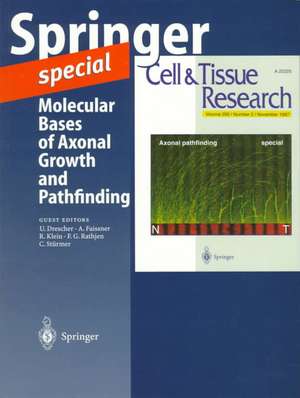Molecular Bases of Axonal Growth and Pathfinding
U. Drescher, A. Faissner, R. Klein, F.G. Rathjen, C. Stürmeren Limba Engleză Paperback – 7 oct 1997
Preț: 649.87 lei
Preț vechi: 764.55 lei
-15% Nou
Puncte Express: 975
Preț estimativ în valută:
124.36€ • 132.98$ • 103.68£
124.36€ • 132.98$ • 103.68£
Carte tipărită la comandă
Livrare economică 18 aprilie-02 mai
Preluare comenzi: 021 569.72.76
Specificații
ISBN-13: 9783540635222
ISBN-10: 354063522X
Pagini: 300
Ilustrații: IX, 283 p. 75 illus.
Dimensiuni: 210 x 277 x 16 mm
Greutate: 0.68 kg
Editura: Springer Berlin, Heidelberg
Colecția Springer
Locul publicării:Berlin, Heidelberg, Germany
ISBN-10: 354063522X
Pagini: 300
Ilustrații: IX, 283 p. 75 illus.
Dimensiuni: 210 x 277 x 16 mm
Greutate: 0.68 kg
Editura: Springer Berlin, Heidelberg
Colecția Springer
Locul publicării:Berlin, Heidelberg, Germany
Public țintă
ResearchDescriere
This CTR-Special is on one of the most exciting topics in the neurosciences, the regulation of axonal growth during development and in the injured nervous system by attraction and repulsion. How the specific wiring of billions of neuronal connections is achieved in the brain has been of interest since the days of Cajal, and even earlier. The implications of this topic extend far beyond developmental neurobiology into the fields of applied medicine, clinical neurology and related disciplines. Following the discoveries of Eph receptors and their ligands, semaphorins and netrins, the field has greatly expanded in the past 2 years and continues to grow. Much of the current fascination for some of these molecules is related to their ambiguous roles in axonal growth promotion and repulsion.
Cuprins
Editorials.- Axonal pathfinding — special.- Axonal growth and pathfinding: from phenomena to molecules.- Role of morphogenetic genes and transcription factors in axon tract formation.- Analysis of axon tract formation in the zebrafish brain: the role of territories of gene expression and their boundaries.- Pax-2 in the chiasm.- Eph receptors and their ligands.- Functional guidance components and their cellular distribution in retinotectal co-cultures.- Genetic analysis of the role of Eph receptors in the development of the mammalian nervous system.- The Eph family: a multitude of receptors that mediate cell recognition signals.- Ephrins and their receptors: a repulsive topic?.- Multiple roles of Eph-like kinases and their ligands during development.- Regulation of topographic projection by the Eph family receptor Bsk (EphA5) and its ligands.- A link between axon guidance and axon fasciculation suggested by studies of the tyrosine kinase receptor EphA5/REK7 and its ligand EphrinA5/AL-1.- Roles of Eph receptors and ephrins in neural crest pathfinding.- Semaphorins and other repulsive guidance cues.- Axon guidance and somites.- Neurotrophins as in vitro growth cone guidance molecules for embryonic sensory neurons.- Patterning neuronal connections by chemorepulsion: the semaphorins.- How do wiring molecules specify cortical connections?.- Extracellular matrix components.- Dual role of Cajal-Retzius cells and reelin in cortical development.- Guidance of circumferentially growing axons by the floor plate in the vertebrate central nervous system.- The tenascin gene family in axon growth and guidance.- Chondroitin sulfate proteoglycans as mediators of axon growth and pathfinding.- Modeling an extracellular environment for axonal pathfinding and fasciculation in the central nervous system.- Synaptic differentiation: the role of agrin in the formation and maintenance of the neuromuscular junction.- Neuronal extracellular proteases facilitate cell migration, axonal growth, and pathfinding.- Neuron-glia interactions in axogenesis and regeneration.- Astrocytic and neuronal factors affecting axon regeneration in the damaged central nervous system.- Glial cell extracellular matrix: boundaries for axon growth in development and regeneration.- Mechanisms of astrocyte-directed neurite guidance.- Growth characteristics of ganglion cell axons in the developing and regenerating retino-tectal projection of the rat.- Cell adhesion molecules.- Cadherins and the formation of neural circuitry in the vertebrate CNS.- The role of cell adhesion molecule L1 in axonal extension, growth cone motility, and signal transduction.- Nr-CAM: A cell adhesion molecule with ligand and receptor functions.- Axonin-1 and NgCAM as “recognition” components of the pathway sensor apparatus of growth cones: a synopsis.- Molecular mechanisms of growth cone guidance: stop and go?.- CAMs and the FGF receptor: an interacting role in axonal growth.- Basic principles and molecular mechanisms of olfactory axon pathfinding.- Roles of a neuronal cell-surface molecule, neuropilin, in nerve fiber fasciculation and guidance.
Caracteristici
The CTR- Special is on one of the most exciting topics in the Neurosciences, the regulation of axonal growth during development and in the injured nervous system by attraction and repulsion.
The implications of this topic extend far beyond developmental neurobiology into the fields of applied medicine, clinical neurology and related disciplines.
The implications of this topic extend far beyond developmental neurobiology into the fields of applied medicine, clinical neurology and related disciplines.














